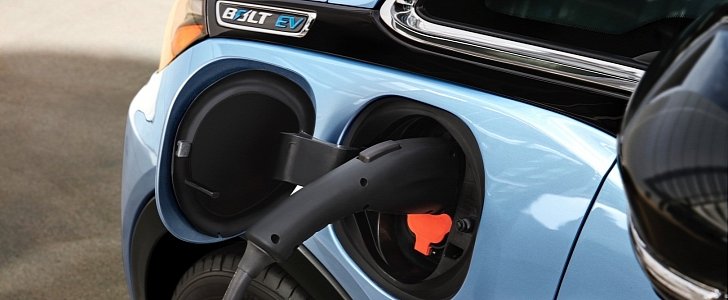After Chevrolet spilled the beans and made it public that the Bolt offers 238 miles of range on the combined cycle, the Environmental Protection Agency website broke down those numbers in city and highway range. Put simply, the Chevrolet Bolt feels at home in the urban jungle. Out of it, it simply doesn’t.
First reported by our friends at InsideEVs, the EPA range ratings for the most talked-about electric vehicle of the moment are 255.1 miles city, 217.4 miles highway, and 238 miles combined. Converted to the metric system, that’ll be 410.5, 349.8, and 383 kilometers. For a vehicle which is priced from $37,495 before vectoring in the federal tax credit, that’s a lot of range on a charge.
Be that as it may, the highway isn’t a friend of the 2017 Chevrolet Bolt due to the shape of the car. The Tesla Model S and its slippery body shell make for a drag coefficient Cd 0.24, while the Chevy Bolt makes do with Cd 0.32. In the words of Stuart Norris, the lead designer of the Bolt, “it’s a disaster for aero.”
On the upside, the entry-level Tesla Model S 60 fares worse than the Chevrolet Bolt, chiefly because 60 kWh capacity and a lot of weight aren’t a good combo either. Also in the Bolt’s defense, the EPA’s testing methodology doesn’t take the Regen-On-Demand system into consideration. By using this function, the driver can increase range by up to 5 percent in stop-and-go city traffic. Then again, not using the brake pedal per se to stop the car is a potentially bad idea, which is definitely not worth the range increase.
On that note, the 2017 Chevrolet Bolt needs about 9.3 hours of charging while plugged into a Level 2 (240-volt) charging station. That’s a heck of a long time if I’m to be honest, especially in a world where a Supercharger can provide the Model S with up to 170 miles (273.5 kilometers) of range in as little as half an hour of charging. Your move, General Motors.
Be that as it may, the highway isn’t a friend of the 2017 Chevrolet Bolt due to the shape of the car. The Tesla Model S and its slippery body shell make for a drag coefficient Cd 0.24, while the Chevy Bolt makes do with Cd 0.32. In the words of Stuart Norris, the lead designer of the Bolt, “it’s a disaster for aero.”
On the upside, the entry-level Tesla Model S 60 fares worse than the Chevrolet Bolt, chiefly because 60 kWh capacity and a lot of weight aren’t a good combo either. Also in the Bolt’s defense, the EPA’s testing methodology doesn’t take the Regen-On-Demand system into consideration. By using this function, the driver can increase range by up to 5 percent in stop-and-go city traffic. Then again, not using the brake pedal per se to stop the car is a potentially bad idea, which is definitely not worth the range increase.
On that note, the 2017 Chevrolet Bolt needs about 9.3 hours of charging while plugged into a Level 2 (240-volt) charging station. That’s a heck of a long time if I’m to be honest, especially in a world where a Supercharger can provide the Model S with up to 170 miles (273.5 kilometers) of range in as little as half an hour of charging. Your move, General Motors.



















































